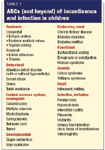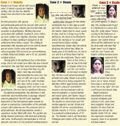Helping the child with daytime wetting stay dry
A careful history, thorough physical examination, and limited diagnostic studies often point the way to the cause and successful treatment of this distressing disorder.
DR. SCHULMAN is adjunct professor of surgery, department of pediatrics, University of Pennsylvania School of Medicine, Philadelphia. He is also associate director, clinical research and development, Wyeth Research, Collegeville, Pa.
MS. BERRY is a pediatric nurse practitioner at the DOVE Center, division of urology, Children's Hospital of Philadelphia. She has nothing to disclose in regard to affiliations with, or financial interests in, any organization that may have an interest in any part of this article.
Children with daytime incontinence wet for different reasons, including medical and anatomic conditions and dysfunctional voiding (Table 1). This review focuses on voiding dysfunction-illustrated by the cases of Brandy, Shaun, and Kayla -that can benefit from a range of treatments. We discuss an approach to evaluating children who wet during the day and consider recommended therapies. In most cases, a careful history, physical examination, and limited diagnostic studies point the way to the cause of the disorder and the direction of treatment.

Where does it all begin?
To understand how voiding goes wrong, brief description of the normal voiding sequence and the maturational processes that lead to continence is worthwhile. The normal voiding sequence comprises the storage phase and the emptying phase. During the storage phase, the bladder fills with urine and a sensation of fullness begins. Central inhibitory pathways prevent bladder emptying until an appropriate time when the choice is made to void. During the emptying phase, the urethral sphincter relaxes and the detrusor (bladder muscle) contracts to cause voiding.

Voiding was once thought to be completely reflexive-that is, the infant's bladder fills and fullness registers in the brainstem, prompting the urethral sphincter to relax and the detrusor muscle to contract, emptying the bladder completely. Recent studies have shown, however, that infants sleep more lightly when they void and that they may contract the sphincter and void incompletely.2
As the toddler grows, he (or she) can store more urine in the bladder and, therefore, voids less often. During the period associated with toilet training, the child accomplishes three tasks. First, he becomes aware of sensations from the bladder and ultimately inhibits contraction of the detrusor muscle through central neurologic pathways in the cortex. Second, he learns to void at will by relaxing the urethral sphincter to initiate the stream, even when voiding is not imperative. Third, he learns to interrupt the stream when he desires to.
The age at which a child attains the ability to remain dry has, in general, increased in recent decades, perhaps because of more permissive training regimens (such as allowing the child to train himself) and the convenience of disposable diapers. A recent survey of healthy Swedish children found that the median age at which daytime dryness is achieved is 3.5 years. Children with a smaller bladder capacity at 6 months of age are likely to take longer to become dry.3

This oversimplification of the cycle of dysfunctional elimination does not explain some perplexing situations, such as why some children who void infrequently do not wet or get infections and what variables predispose other children to recurrent infection despite normal voiding. Nevertheless, understanding and breaking the cycle may lead to symptomatic relief without the need for extensive studies or medication.